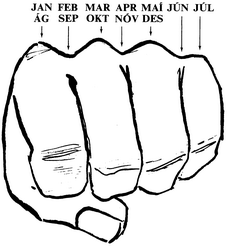The First Day of Summer, Icelandic-Style (and a Knuckle-Calendar, Just For Fun) Posted by Meg on Apr 20, 2017 in Icelandic culture, Icelandic customs, Icelandic history
Today in Reykjavik, it was a whopping 3 degrees (C), even though it is, according to the Icelanders, the first day of summer.
The old Icelandic calendar is called the misseristal, or semester-count, and it’s been used since the Settlement Age. It emphasizes the two “semesters” of the year – summer and weather – with an additional few days during summer to account for discrepancies.
The First Day of Summer, or sumardagurinn fyrsti, falls on the first day of the first summer month in the misseristal: Harpa, which was dedicated to the maiden. That day is always the second Thursday after the feast day of Pope Leo I – April 11 – each year. Some sources say that it takes place on the first Thursday after April 18, but the oldest tradition stems from this more oddly-specific schematic.
Around this time of year, when Iceland was still primarily agrarian, the hay supplies were usually depleted and the livestock needed to be moved outdoors, so it was sort of crucial that summer arrive.
But it can be hard to keep track of the days (especially with the proliferation of Feast Days – because, hey, who doesn’t want an excuse to party?) without a formal calendar or newspapers and other methods of communication, so the Icelanders used a method to called fingrarím (finger-rhyme). Here’s a paraphrase/translation of one possible set of rules of a fingrarím, along with a helpful diagram, as recorded by Þorsteinn Sæmundsson:
The names of the months are counted up in order. For the first month, January, the index finger on the right hand is laid on the outermost knuckle of the left hand, which is clenched in a fist (as in the above image). For the second name, February, the finger is moved over to the space between the outermost knuckle and the next one.
Still with me?
For the third month, March, the finger is moved to the next knuckle. And so on so forth until you arrive at the last knuckle, July, and then you return again to the first knuckle, which now represents August. Months with 31 days, therefore, are on knuckles, and the shorter months are all in the space between knuckles.
Now back to the subject at hand (forgive the pun). This day is accompanied by a number of traditions (besides the hope that it’ll be warm henceforth), including parades, events, and giving small gifts to children (unsurprisingly called “summer gifts”), which Icelanders have done since the 16th century. The tradition of giving gifts on sumardagurinn fyrsti even precedes Christmas gifts in Iceland by about 3 centuries!
The last fun fact I want to impart relates to, well, the weather. It’s seen as a good sign if it’s cold (or cold-ish) on the first day of summer. If one, for example, leaves a bucket of water outside during the night (before sumardagurinn fyrsti), only to find it frozen over in the morning, then summer and winter are considered to have “frozen together” (“saman frysti sumar og vetur”). And popular tell is that this union indicates a good summer ahead.
So given the erratic weather of the last few days (oscillating between rain-coat weather and Canada Goose weather), I’m optimistic.
With warm greetings from a snowy, sunshiny, and not too too cold Reykjavik –
Meg

Build vocabulary, practice pronunciation, and more with Transparent Language Online. Available anytime, anywhere, on any device.





Comments:
Helen:
Gleðilegt sumar!
This way of counting the months is found in the UK too. We learned how to remember how many days were in each month by touching our knuckles. We also learned a rhyme. (30 days hath September…). Is there a similar rhyme in Icelandic?
Thank you for your blog.
Helen.
Þórir Pétur:
@Helen Here is the most commonly told rhyme about the days of the months:
Ap, jún, sept, nóv þrjátíu hver.
Einn til hinir kjósa sér.
Febrúar tvenna fjórtán ber
frekar einn þá hlaupár er.
I have also heard of a one that is a bit longer, but I cannot remember it.
Þórir Pétur:
I always enjoyed fingrarím when I was a kid (my grandmother taught me quite a few), and I still remember the simple one to find out the weekdays of certain days, like for example the first day of summer. I also kinda remember parts of the really complicated fingrarím of finding out what day Easter is, but that involves a bit longer process, and uses couple of different fingrarím on top of each other. Bit hard to remember XD
Anyways, really enjoyed this post. Don’t know if lot of snow and near zero temperature, but little actual frost/below zero temperature counts as “frjósa saman / freezing together”, but I am holding out hope.
Looking forward for your next post.
Helen:
@Þórir Pétur Takk Þórir Pétur!